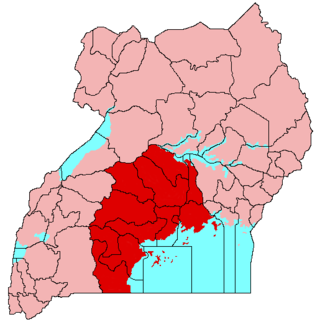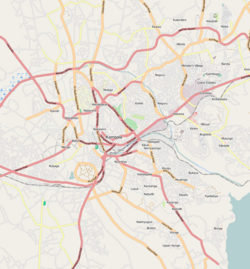
Buganda is a Bantu kingdom within Uganda. The kingdom of the Baganda people, Buganda is the largest of the traditional kingdoms in present-day East Africa, consisting of Buganda's Central Region, including the Ugandan capital Kampala. The 14 million Baganda make up the largest Ugandan region, representing approximately 26.6% of Uganda's population.
Sir Edward Frederick William David Walugembe Mutebi Luwangula Mutesa II was Kabaka of the Kingdom of Buganda in Uganda from 22 November 1939 until his death. He was the thirty-fifth Kabaka of Buganda and the first president of Uganda. The foreign press often referred to him as King Freddie, a name rarely used in Uganda. An ardent defender of Buganda's interests, especially its traditional autonomy, he often threatened to make the kingdom independent both before and after Uganda's independence to preserve it. These firm convictions also later led to conflicts with his erstwhile political ally Milton Obote, who would eventually overthrow him.

Daudi Chewa II was Kabaka of the Kingdom of Buganda from 1897 until 1939. He was the 34th Kabaka of Buganda has a surviving daughter, Princess Addah Balilara lives in Bujjuko, Kampala
Ronald Edward Frederick Kimera Muwenda Mutebi II is the reigning Kabaka of the Kingdom of Buganda, a constitutional kingdom in modern-day Uganda. He is the 36th Kabaka of Buganda.

Kabaka is the title of the king of the Kingdom of Buganda. According to the traditions of the Baganda they are ruled by two kings, one spiritual and the other secular.
Ssuuna II Kalema Kasinjo Mukaabya Sekkyungwa Muteesa Sewankambo Walugembe Mig'ekyaamye Lukeberwa Kyetutumula Magulunyondo Luwambya Omutanda Sseggwanga was Kabaka of the Kingdom of Buganda from 1832 until 1856. He was the twenty-ninth Kabaka of Buganda.
Mengo is a hill in Rubaga Division, Kampala, Uganda's capital and largest city. The name also applies to the neighborhood on that hill.
Lubaga is a hill in Kampala, Uganda's capital and largest city. It comes from the Luganda word okubaga, describing a process of "planning" or "strengthening" a structure while constructing it. For example, okubaga ekisenge means to strengthen the internal structure of a wall while building a house. The name also applies to the neighborhood on the hill.
Rubaga Division, also Lubaga Division, is one of the divisions that makes up the city of Kampala, Uganda. The division takes its name from Rubaga, where the division headquarters are located.

Muteesa I Mukaabya Walugembe Kayiira was the 30th Kabaka of the Kingdom of Buganda, from 1856 until 1884.
Namirembe is a hill in Kampala, Uganda's capital and largest city. It is also a common name given to girls in several Baganda clans. Namirembe comes from the Luganda word "mirembe" meaning peace. Namirembe loosely translates into Full of Peace. Legend has it that this hill was a gathering place for celebrating peace or war victories.

Muteesa I Royal University (MRU) is a private university in Uganda. It was accredited by the Uganda National Council for Higher Education (UNCHE) in 2007. On 15 June 2016, Justice Julia Sebutinde was installed as Chancellor of the University, replacing Ronald Muwenda Mutebi II, the founding chancellor who became The Visitor of the University.
Banda is a hill that lies in Nakawa Division, within Kampala, the capital of Uganda. Banda also refers to the neighborhoods on the slopes of the hill and between Banda Hill and Kireka, extending all the way to the Kampala-Jinja Highway. The southwestern slopes of the hill are occupied by the neighbourhood known as Kyambogo, and is the location of the campus of Kyambogo University, one of the nine public universities in the country.

The Kasubi Tombs in Kampala, Uganda, is the site of the burial grounds for four kabakas and other members of the Baganda royal family. As a result, the site remains an important spiritual and political site for the Ganda people, as well as an important example of traditional architecture. It became a UNESCO World Heritage Site in December 2001, when it was described as "one of the most remarkable buildings using purely vegetal materials in the entire region of sub-Saharan Africa".

The Ganda people, or Baganda, are a Bantu ethnic group native to Buganda, a subnational kingdom within Uganda. Traditionally composed of 52 clans, the Baganda are the largest people of the bantu ethnic group in Uganda, comprising 16.5 percent of the population at the time of the 2014 census.

Bulange (boo-lah-ngeh), is a building in Uganda. It houses the Lukiiko (Parliament) of the Kingdom of Buganda. The Kabaka of Buganda and the Katikkiro of Buganda also maintain offices in the building. The building serves as the administrative headquarters of the Buganda Kingdom.
Charles Peter Mayiga is a Ugandan lawyer, cultural leader and author. He is the current katikkiro in the government of Buganda, a constitutional monarchy in present-day Uganda. He was appointed to that position by the reigning Kabaka of Buganda, His Majesty Muwenda Mutebi II of Buganda, in May 2013, replacing engineer John Baptist Walusimbi.
{{Infobox religious building | building_name= Rubaga Cathedral | image=Rubaga Cathedral.jpg | image_size=300px | caption= | location=Lubaga, Kampala, Uganda | geo=0°18′09″N32°33′08″E | religious_affiliation=Roman Catholic | district= Archdiocese of Kampala | consecration_year= 1925 | status=Major Cathedral | leadership= Archbishop [[Paul Ssemogerere ] | website= | architect= | architecture_style= | groundbreaking = 1914 | year_completed= 1925 | specifications = yes | capacity = | length = | width = | height_nave = | height_max = | dome_dia_outer = }}
Kibulala, Ssingo, commonly known as Kibulala, is a hill in Ssingo County, Kiboga District in Central Uganda. The hill rises approximately 1,250 metres (4,100 ft) above sea level. The name also applied to the village that sits on top of the hill and the Buganda cultural site located there.
Buganda Investments and Commercial Undertakings Limited(BICUL), is a holding company of the investment and business entities, owned by the Kingdom of Buganda, a constitutional monarchy in modern-day Uganda Kabaka of Buganda









